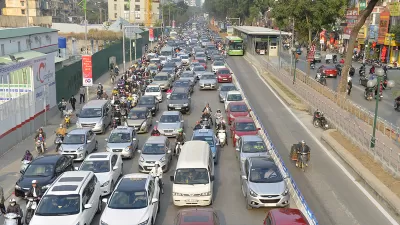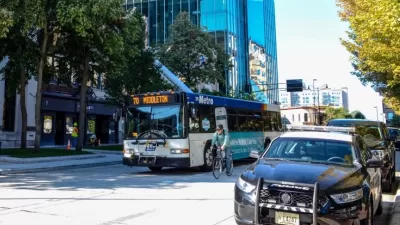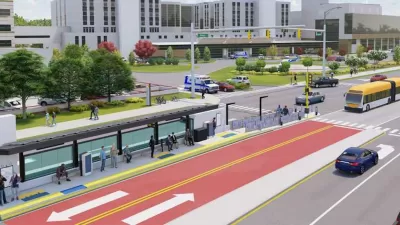Vietnam's capital is internationally known for pollution and traffic, the government is trying to take on both with a rapid transit bus system, but many remain skeptical.

In the fast-growing city of Hanoi, more people has meant more traffic and more pollution. "Hanoi’s PM2.5 levels typically range from 100 to 200 micrograms per cubic metre – regularly within the globally acknowledged 'unhealthy' category. But on 19 December last year, they hit “hazardous levels" at 343μg/m3, which was higher than Beijing," reports Zung Nguyen in The Guardian.
The city has looked to address those challenges, in part, by launching a Bus Rapid Transit (BRT) system on the last day of 2016. With dedicated bus lanes not open to cars or the city's plentiful motorcycle commuters, "[m]any are angry that the BRT’s exclusive lane takes up almost half of some roads, exacerbating congestion for other motorbikes and cars," Nguyen writes. The success or failure of the system will depend on how widely adopted it is and, while the early numbers of riders are growing, some worry that they won't grow fast enough to make a dent in either the traffic or the pollution problem.
FULL STORY: Hope for Hanoi? New bus system could cut pollution … if enough people use it

Trump Administration Could Effectively End Housing Voucher Program
Federal officials are eyeing major cuts to the Section 8 program that helps millions of low-income households pay rent.

Planetizen Federal Action Tracker
A weekly monitor of how Trump’s orders and actions are impacting planners and planning in America.

Ken Jennings Launches Transit Web Series
The Jeopardy champ wants you to ride public transit.

Crime Continues to Drop on Philly, San Francisco Transit Systems
SEPTA and BART both saw significant declines in violent crime in the first quarter of 2025.

How South LA Green Spaces Power Community Health and Hope
Green spaces like South L.A. Wetlands Park are helping South Los Angeles residents promote healthy lifestyles, build community, and advocate for improvements that reflect local needs in historically underserved neighborhoods.

Sacramento Plans ‘Quick-Build’ Road Safety Projects
The city wants to accelerate small-scale safety improvements that use low-cost equipment to make an impact at dangerous intersections.
Urban Design for Planners 1: Software Tools
This six-course series explores essential urban design concepts using open source software and equips planners with the tools they need to participate fully in the urban design process.
Planning for Universal Design
Learn the tools for implementing Universal Design in planning regulations.
Heyer Gruel & Associates PA
Ada County Highway District
Institute for Housing and Urban Development Studies (IHS)
City of Grandview
Harvard GSD Executive Education
Toledo-Lucas County Plan Commissions
Salt Lake City
NYU Wagner Graduate School of Public Service





























